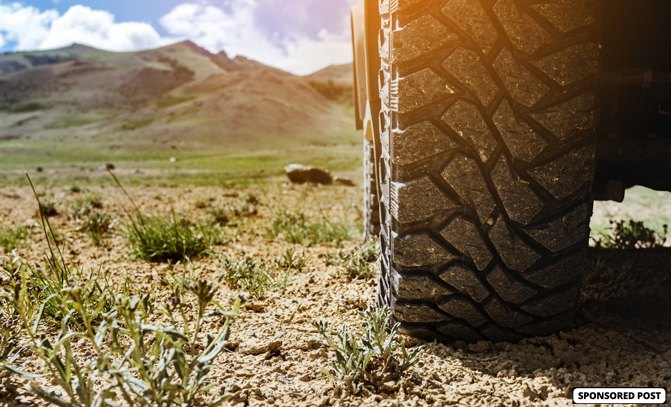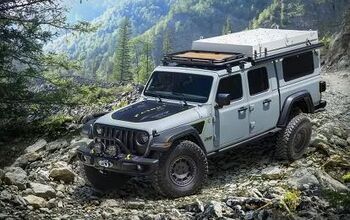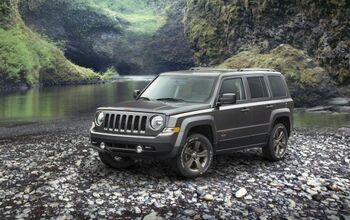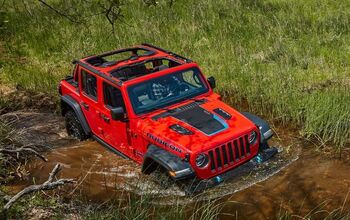Best Jeep Tires: Jeep Thrills
Top 10 Best Jeep Tires
There’s no question the Jeep brand has been on a bit of a roll. After launching the new Wrangler a couple of model years ago, they followed that up with the similar-but-really-not Gladiator and are set to (finally) have a three-row offering in the new year. Combine that with volume from the Cherokees – both Grand and un-Grand – plus the Renegade, and FCA essentially has a license to print money.
Makes you wonder what PSA’s real endgame is with the merger, eh?
Regardless, the venerable Wrangler is, and probably always will be, the face of this brand. We’ve partnered with eBay Motors to bring you this list of the best Jeep tires, presented in no particular order. Whether you use them to rock crawl or mall crawl is entirely up to you. We won’t judge. Much.
Table of Contents
-
BFGoodrich All-Terrain T/A KO2: Shop Now
-
BFGoodrich Mud-Terrain T/A KM3: Shop Now
-
Goodyear Wrangler MT/R: Shop Now
-
Goodyear Wrangler DuraTrac: Shop Now
-
Falken Wildpeak A/T3W: Shop Now
-
General Grabber X3: Shop Now
-
Nitto Ridge Grappler: Shop Now
-
Milestar Patagonia M/T: Shop Now
-
Federal Couragia M/T: Shop Now
-
Cooper Discoverer STT Pro: Shop Now
1. BFGoodrich All-Terrain T/A KO2
These rugged hoops might not be the first to place an emphasis on how an off-road tire looks, but they sure did popularize the notion. When the KO2 first appeared on shop shelves, complete with those aggressively-styled sidewall shoulders, interested buyers were tripping over themselves to snag a set.
Including your author, it must be said. A set of these replaced the dismal factory rubber on a then-young Ram 1500 Sport, a truck I enjoyed but am glad is gone. BFGoodrich KO2 tires employ triangular rock ejectors in their tread voids, flex bars that use science to break vacuum and fling mud clear from the blocks, and a Cheetos-shaped tread design that provides stout traction properties.
Pros
- Well-known brand, looks baller
Cons
- Not exactly a unique choice
2. BFGoodrich Mud-Terrain T/A KM3
Cousin to the KO2 above, the KM3 is designed specifically for duty in thick mud or other goopy terrain. These tires also incorporate the stone and mud ejectors, but the tread pattern is very different from that of the KO2. Suffice to say you will notice these things on the highway.
A couple of years ago, this author took a Jeep Wrangler through the sticks of Vermont on a set of these tires. The spring runoff and subsequent mire proved to be a formidable but not unsurmountable foe, with the Jeep (and an LS-swapped Defender 90) making it back to base camp in time for supper.
Pros
- KM2's will simply beat the mud into submission
Cons
- They'll beat you into submission on pavement
3. Goodyear Wrangler MT/R
Another tire designed specifically for the mud, this Wrangler MT/R has an asymmetric-ish tread design that looks like nothing else on the market. Goodyear explains this decision as the best way to strike a balance between off-road prowess and reasonably good handling on paved roads.
Reinforced sidewalls are said to add 35% more cut and puncture resistance compared to a standard MT/R, according to Goodyear's own tests. The steel belts are infused with Kevlar, a product often associated with police-grade bulletproof vests.
Pros
- Asymmetric design, attractive price on some sizes
Cons
- You'll have to constantly explain them
4. Goodyear Wrangler DuraTrac
If you think there are more branches to the Goodyear Wrangler family tree than the number found on a 100-year-old oak, you'd be exactly right. The long-running Wrangler Duratrac line has been revamped on a number of occasions over the years, with the iteration shown before you delivering on current desires for aggressive (read: show-off) sidewall design.
It's a workhorse tire designed for rough terrain of all types, including snow. Speaking to that point, LT sizes are pinned for #16 metal studs, if your jurisdiction permits that type of rubber. The highly angled traction blocks make for a decent on-road experience.
Pros
- Three-peak mountain rated, refined design over the years
Cons
- Unfairly derided as a 'dad' tire in some circles
5. Falken Wildpeak A/T3W
The 'W' appended to this tire's name doesn't stand for 'winner'... but it could. Instead denoting its suitability in the white stuff – and attendant three-peak rating – the A/T3W is said to combine aggressive off-road ability and rugged terrain driving. Looking closely at the tread design, angled with wide, but not cavernous voids, there's a solid chance these things won't be too much of a headache on the road.
Falken promotes these things as having the deepest tread depth in its category, with some 20/32nds on most LT sizes. Those lines on its sidewall just above the wheel are more than just fanciful design; they're part of a heat diffuse technology intended to keep the tire cool. This'll help while towing or carrying heavy payload.
Pros
- Impressive technology, thoughtful and practical design
Cons
- Customers with 19-inch wheels are currently outta luck
6. General Grabber X3
Back to the mud terrain ledger, these General Grabbers make a bold statement when opted with the red sidewall lettering. Although, we ask, why not? White lettering has been around for ages. Perhaps it’s time for another color to have a shot.
A multi-pitch pattern design attempts to keep a lid on pavement noise, though there's no doubt these tires are more at home in a deep mud pit than at the mall. Siped treads will evacuate water making them suitable for snow running, though they are not winter rated.
Pros
- Snazzy lettering, ample size choices
Cons
- No three-peak approval
7. Nitto Ridge Grappler
We often wonder if Nitto and General have ever gone after each other for the brands of their respective off-road tires, given there's a marked similarity between the names. Regardless of marketing fights, the Ridge Grappler is known as a hybrid terrain tire, one which combines deep aggressive sidewall lugs with a tread pattern to claw its way through off-road muck.
Nitto promotes something called a 'variable pitch' tread pattern, which apparently creates a pattern that provides a quiet highway ride compared to some of its competition. Lateral z-shaped grooves are set a zig-zag pattern for maximum bite.
Pros
- Good looks, staggered lugs for extra sidewall traction when aired down
Cons
- Some real-world reports of different wear levels
8. Milestar Patagonia M/T
This company is one of those brands which seems to appear out of nowhere to take on the establishment. Available in LT and flotation sizes (that's the "33- or 35-inch" crowd for you noobs), they're certainly doing a good job of trying to penetrate the market.
A high void tread design is a good sign these tires will be good in the mud, and there's no doubt they look the part. Tougher to ascertain, however, is the chemical compounds used to create the tire itself. Rock hard tires don't provide much grip, after all, no matter how good the tread design. What cannot be argued, however, is the raft of positive online reviews.
Pros
- Affordable
Cons
- What brand?
9. Federal Couragia M/T
Federal isn't exactly known as a huge player in the off-road tire game, but this variant of truck and 4x4 tire certainly has a cult following. Available with up to an 85-series sidewall, its uniquely designed incremental block edge is said to quickly shed dirt, sand, and gravel for off-road performance.
The list of available sizes is quite long, going all the way up to a brodozer-riffic 24 inches in wheel diameter on a 40-inch flotation size. LT measures are also offered. The widest options put an entire foot of rubber to the ground.
Pros
- Unique look, ardent fan base
Cons
- Reviewers seem to either love or hate these things
10. Cooper Discoverer STT Pro
No, the good folks at Cooper don't have a stutter, though the extra 'er' at the end of this tire's name can cause some double takes. This particular variant is a mud-terrain option, built to mash its way through the mire while taking on all-season duty back at the pavement.
Cooper calls this the 'most extreme' all-season off-road tire they have yet to offer, claiming the Armor Tek3 construction adds durability while adding soft-surface cleats to its sidewall shoulder will help one find extra purchase. Yes, tread design has gotten wider than ever, spilling out to the sidewall in addition to the tire's surface.
Pros
- Alternating shoulder lugs, mud-release dimples
Cons
- Oddball lettering choices
From time to time, TTAC will highlight automotive products we think may be of interest to our community. Plus, posts like this help to keep the lights on around here. Learn more about how this works.
(Editor’s note: This post is meant to both help you be an informed shopper for automotive products but also to pay for our ‘90s sedan shopping habits operating expenses. Some of you don’t find these posts fun, but they help pay for Junkyard Finds, Rare Rides, Piston Slaps, and whatever else. Thanks for reading.)
More by TTAC Staff
Latest Car Reviews
Read moreLatest Product Reviews
Read moreRecent Comments
- Mike Beranek In the sedan game, it's now either Camry or Accord. The rest are just background noise.
- Theflyersfan I know their quality score hovers in the Tata range, but of all of the Land Rovers out there, this is the one I'd buy in a nanosecond, if I was in the market for an $80,000 SUV. The looks grew on me when I saw them in person, and maybe it's like the Bronco where the image it presents is of the "you're on safari banging around the bush" look. Granted, 99% of these will never go on anything tougher than a gravel parking lot, but if you wanted to beat one up, it'll take it. Until the first warning light.
- Theflyersfan $125,000 for a special M4. Convinced this car exists solely for press fleets. Bound to be one of those cars that gets every YouTube reviewer, remaining car magazine writer, and car site frothing about it for 2-3 weeks, and then it fades into nothingness. But hopefully they make that color widespread, except on the 7-series. The 7-series doesn't deserve nice things until it looks better.
- Master Baiter I thought we wanted high oil prices to reduce consumption, to save the planet from climate change. Make up your minds, Democrats.
- Teddyc73 Oh look dull grey with black wheels. How original.












































Comments
Join the conversation
Do drag radials.
Considering how many Jeeps will never go off-road, maybe a good set of all-season tires suitable for 90% dry pavement, 8% wet pavement, and 2% snow would be a better choice. Nearly half the drivers will be women driving automatics, and their standards of handling, NVM, and ride comfort are closer to the standards of Consumer Reports than off-roaders.